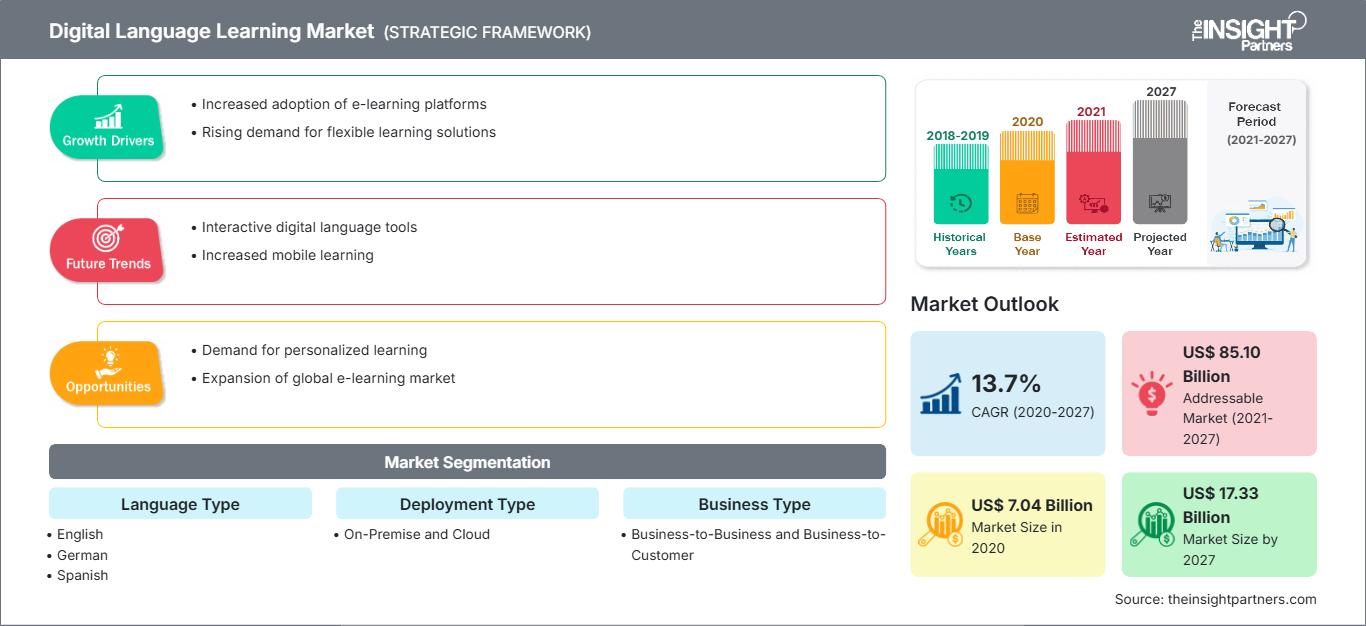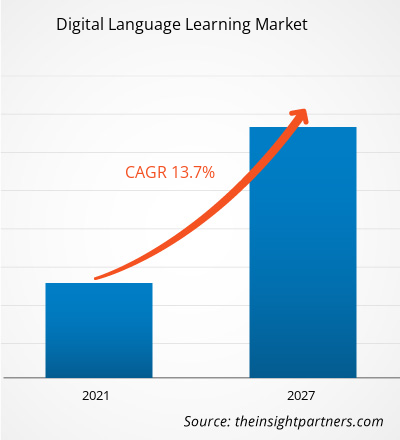Si prevede che il mercato dell'apprendimento digitale delle lingue crescerà da 7.038,2 milioni di dollari nel 2020 a 17.333,4 milioni di dollari entro il 2027; si stima una crescita a un CAGR del 13,7% dal 2020 al 2027.
Le iniziative di vari governi per implementare programmi di apprendimento della lingua inglese contribuiscono alla crescita del mercato. Il settore dell'istruzione globale si sta trasformando in modo esponenziale grazie a varie iniziative intraprese da governi e organizzazioni private per offrire prestazioni migliorate digitalmente. I governi di vari paesi come Cina, Australia, Brasile ed Emirati Arabi Uniti hanno avviato programmi di istruzione digitale negli ultimi anni, aiutando questi paesi a potenziare i loro sistemi di istruzione in inglese. Ad esempio, la Digital Education Revolution (DER) del governo australiano, avviata dieci anni fa, ha permesso a diverse scuole e università di sfruttare l'istruzione digitale. Allo stesso modo, il governo cinese ha avviato diverse politiche per promuovere l'istruzione digitale, con particolare attenzione all'apprendimento della lingua inglese, il che ha favorito l'aumento del numero di aziende che offrono soluzioni di apprendimento digitale agli studenti cinesi. 51Talk è uno dei più importanti istituti di apprendimento digitale della lingua inglese in Cina; 17Zuoye è un'altra piattaforma digitale per studenti, insegnanti e genitori cinesi, che fornisce compiti online sotto forma di esercizi e compiti a casa, consentendo agli utenti finali di migliorare le proprie competenze. Attualmente, l'India sta accelerando la creazione di un mercato sostanziale per l'istruzione digitale. Il governo indiano ha intrapreso diverse iniziative per diffondere le tecnologie di digitalizzazione nel settore dell'istruzione. SWAYAM è la piattaforma di apprendimento digitale più importante e l'iniziativa intrapresa dal governo indiano, che aiuta gli studenti a scegliere corsi online che coprono tutte le materie dell'istruzione superiore. Anche le università internazionali possono offrire i propri corsi ed esami tramite la piattaforma SWAYAM, facilitando così l'apprendimento e la scelta degli studenti per gli esami presso università internazionali. Questo fattore migliora le capacità di apprendimento, espressione orale e scrittura dell'inglese degli studenti. La Biblioteca digitale nazionale è un'altra iniziativa implementata dal governo indiano con l'obiettivo di offrire una fonte virtuale di risorse didattiche, tramite un unico sportello. Questa iniziativa sta acquisendo gradualmente importanza e si prevede che stimolerà la crescita del mercato dell'apprendimento digitale della lingua inglese in India nei prossimi anni, contribuendo così alla crescita del mercato globale dell'apprendimento digitale delle lingue.
Personalizza questo rapporto in base alle tue esigenze
Potrai personalizzare gratuitamente qualsiasi rapporto, comprese parti di questo rapporto, o analisi a livello di paese, pacchetto dati Excel, oltre a usufruire di grandi offerte e sconti per start-up e università
Mercato dell'apprendimento digitale delle lingue: Approfondimenti strategici

-
Ottieni le principali tendenze chiave del mercato di questo rapporto.Questo campione GRATUITO includerà l'analisi dei dati, che vanno dalle tendenze di mercato alle stime e alle previsioni.
Il recente scoppio della pandemia ha portato notevoli cambiamenti positivi nel settore dell'istruzione a livello globale negli ultimi mesi. Inoltre, la rivoluzione nelle istituzioni educative convenzionali e nelle tecniche di apprendimento in aula ha visto un'impennata nell'adozione di soluzioni di apprendimento online e digitali solide ed efficienti che si prevede continueranno a sostenere la crescita del mercato anche dopo la pandemia nei prossimi anni. Ad esempio, l'UNESCO, insieme a diversi rappresentanti di spicco del settore tecnologico e dell'ITU (Unione Internazionale delle Telecomunicazioni), ha collaborato per sottolineare l'importanza economica dell'adozione delle tecnologie digitali nell'apprendimento, al fine di consentire capacità di apprendimento rapide a un pubblico più ampio senza investimenti considerevoli in infrastrutture fisiche nelle economie emergenti. In un sondaggio separato condotto dall'Università di Cambridge, oltre 1.200 intervistati hanno identificato una maggiore propensione a continuare a utilizzare le tecnologie di apprendimento digitale tra il 60% dei candidati al sondaggio nei prossimi anni. Pertanto, la recente epidemia ha favorito un'impennata nell'adozione delle tecnologie di apprendimento digitale e, di conseguenza, ha avuto un impatto positivo sulla crescita del mercato negli ultimi mesi.
Approfondimenti di mercato: il mercato dell'apprendimento digitale delle lingue sfrutta tecnologie avanzate e semplificate per attrarre gli studenti verso l'istruzione digitale
Nei paesi sviluppati, come gli Stati Uniti e il Regno Unito, il sistema di istruzione digitale ha guadagnato un'enorme popolarità poiché gli studenti di scuole, università e altri istituti sono pienamente consapevoli delle tecnologie. Tuttavia, nei paesi APAC e SAM, gli studenti non sono consapevoli dell'apprendimento basato sulla tecnologia. Diverse scuole, università e istituti di formazione stanno implementando le tecnologie digitali nelle loro classi. Mentre gli sviluppatori di piattaforme didattiche digitali aggiornano costantemente le loro tecnologie per offrire soluzioni solide, gli utilizzatori nell'APAC stanno aggiornando costantemente la loro infrastruttura tecnologica. Si prevede che le innovative app didattiche basate su cloud, i siti web e altri servizi creeranno un mercato significativo per l'istruzione digitale, comprese le soluzioni per l'apprendimento digitale delle lingue.
Approfondimenti basati sul tipo di lingua
In base al tipo di lingua, il mercato dell'apprendimento digitale delle lingue è segmentato in inglese, mandarino, spagnolo, tedesco e altre. Il segmento inglese ha detenuto la quota di mercato maggiore nel 2019.Approfondimenti regionali sul mercato dell'apprendimento digitale delle lingue
Le tendenze e i fattori regionali che influenzano il mercato dell'apprendimento digitale delle lingue durante il periodo di previsione sono stati ampiamente spiegati dagli analisti di The Insight Partners. Questa sezione illustra anche i segmenti e la geografia del mercato dell'apprendimento digitale delle lingue in Nord America, Europa, Asia-Pacifico, Medio Oriente e Africa, America meridionale e centrale.
Ambito del rapporto di mercato sull'apprendimento digitale delle lingue
| Attributo del rapporto | Dettagli |
|---|---|
| Dimensioni del mercato in 2020 | US$ 7.04 Billion |
| Dimensioni del mercato per 2027 | US$ 17.33 Billion |
| CAGR globale (2020 - 2027) | 13.7% |
| Dati storici | 2018-2019 |
| Periodo di previsione | 2021-2027 |
| Segmenti coperti |
By Tipo di lingua
|
| Regioni e paesi coperti |
Nord America
|
| Leader di mercato e profili aziendali chiave |
|
Densità degli attori del mercato dell'apprendimento digitale delle lingue: comprendere il suo impatto sulle dinamiche aziendali
Il mercato dell'apprendimento digitale delle lingue è in rapida crescita, trainato dalla crescente domanda degli utenti finali, dovuta a fattori quali l'evoluzione delle preferenze dei consumatori, i progressi tecnologici e una maggiore consapevolezza dei vantaggi del prodotto. Con l'aumento della domanda, le aziende stanno ampliando la propria offerta, innovando per soddisfare le esigenze dei consumatori e sfruttando le tendenze emergenti, alimentando ulteriormente la crescita del mercato.

- Ottieni il Mercato dell'apprendimento digitale delle lingue Panoramica dei principali attori chiave
Gli operatori che operano nel mercato dell'apprendimento digitale delle lingue si concentrano principalmente sullo sviluppo di prodotti avanzati ed efficienti.
- Nel 2019, Fluenz ha annunciato l'espansione del suo programma di immersione di lusso in spagnolo a Barcellona, in Spagna, nella primavera del 2020. Gli utenti avrebbero potuto partecipare al programma per sei giorni per l'apprendimento delle lingue.
- Nel 2018, Preply, Inc. ha annunciato i suoi piani per l'apertura di un nuovo ufficio a Barcellona all'inizio del 2019. L'espansione è stata il risultato di un finanziamento di 4 milioni di dollari a luglio. L'azienda prevede inoltre di espandere la propria presenza nei mercati tedesco, britannico, americano e latinoamericano.
Il mercato dell'apprendimento digitale delle lingue è stato segmentato come segue:
Mercato globale dell'apprendimento digitale delle lingue - Per tipo di lingua
- Inglese
- Tedesco
- Spagnolo
- Mandarino
- Altro
Mercato globale dell'apprendimento digitale delle lingue - Per tipo di distribuzione
- In sede
- Cloud
Mercato globale dell'apprendimento digitale delle lingue - Per tipo di attività
- Business-to-Business
- Business-to-Customer
Mercato globale dell'apprendimento digitale delle lingue - Per Utente finale
- Accademico
- Non accademico
Mercato globale dell'apprendimento delle lingue digitali - per area geografica
- Nord America
- Stati Uniti
- Canada
- Messico
- Europa
- Francia
- Germania
- Italia
- Russia
- Regno Unito
- Resto d'Europa
- Asia Pacifico (APAC)
- Giappone
- Cina
- Australia
- India
- Corea del Sud
- Resto dell'APAC
- Medio Oriente e Africa (MEA)
- Arabia Saudita
- Emirati Arabi Uniti
- Sudafrica
- Resto del MEA
- Sud America (SAM)
- Brasile
- Argentina
- Resto di SAM
Mercato dell'apprendimento digitale delle lingue - Profili aziendali
- Babbel
- Busuu, Ltd.
- Fluenz
- Lingoda GmbH
- Living Language (Penguin Random House, LLC)
- Pearson PLC
- Preply, Inc.
- Rosetta Stone, Inc.
- Verbling, Inc.
- Yabla, Inc.
- Analisi storica (2 anni), anno base, previsione (7 anni) con CAGR
- Analisi PEST e SWOT
- Valore/volume delle dimensioni del mercato - Globale, Regionale, Nazionale
- Industria e panorama competitivo
- Set di dati Excel
Report recenti
Rapporti correlati
Testimonianze
Motivo dell'acquisto
- Processo decisionale informato
- Comprensione delle dinamiche di mercato
- Analisi competitiva
- Analisi dei clienti
- Previsioni di mercato
- Mitigazione del rischio
- Pianificazione strategica
- Giustificazione degli investimenti
- Identificazione dei mercati emergenti
- Miglioramento delle strategie di marketing
- Aumento dell'efficienza operativa
- Allineamento alle tendenze normative






















 Ottieni un campione gratuito per - Mercato dell'apprendimento digitale delle lingue
Ottieni un campione gratuito per - Mercato dell'apprendimento digitale delle lingue